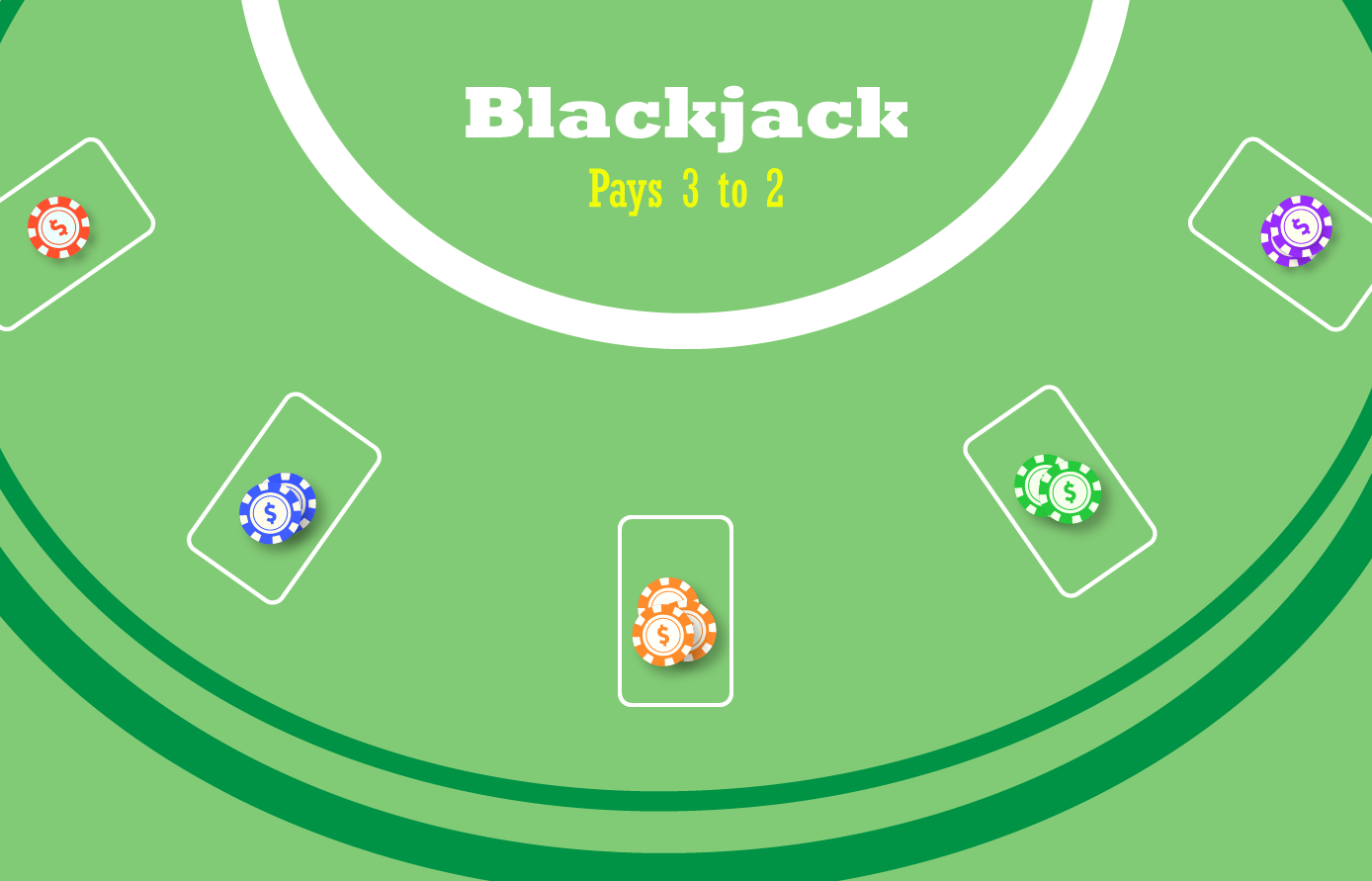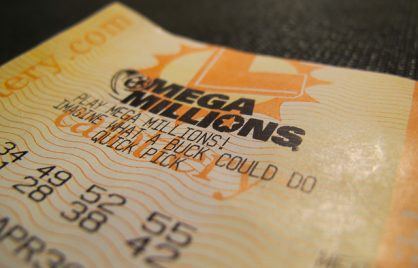A Step-by-Step Guide On How To Deal Blackjack (With Pictures)
Blackjack is a fairly easy game to follow as a player, but there are a lot of nuances to pay attention to when dealing blackjack. With that in mind, we’ve prepared a step-by-step guide on how to deal blackjack, including all blackjack dealer rules.
- Have players place their bets
- Deal one face-up card to every player
- Place one face-down card in front of you
- Deal the second face-up card to everyone
- Deal additional cards as requested
- Show your face-down card and make your hand
- Compare hands to determine the winner
- Collect all cards to end the round
Step 1: Have Players Place Their Bets

Once you’ve shuffled and cut the cards, but before you deal them, have all of the players place their bets. The players who want to participate in the upcoming hand do so by making their bets at this point.
Players who decide to be in the game will have to place their chips in the small circle or box in front of them. If the blackjack table doesn’t include this area, the players can simply put their chips next to the area where you’ll place their cards.
Any player who doesn’t make a bet before you start dealing won’t receive any cards and can’t participate in the round.
Remember, as the dealer, you don’t have to place any bets. You’re acting as the “house.” In a home game, players should rotate after each hand, so each person acts as the dealer at one point.
Step 2: Deal One Face-Up Card To Every Player

After the players have placed their bets, you can start dealing. The proper way to deal blackjack cards is to distribute them from left to right.
Take the top card from the deck (or the first card from the blackjack card shoe if you’re using one) and deal it to the leftmost player at the table.
Gently slide the card across the table and turn it face up while doing so. Place the first player’s card in the designated box in front of them. Continue the same with every following player until everyone in the round has one face-up card in front of them.
Whether you’re dealing at home or in a professional setting, keep in mind that only you can touch the cards. The players can’t touch their cards even to adjust them.
Step 3: Place One Face-Down Card In Front Of You

Once every player in the round has their face-up card, you should take the top card from the deck or the card shoe and place it face-down in front of yourself.
It’s crucial to keep the card hidden from all of the players in the game until it’s time to reveal it, so be careful when taking it from the deck. At this point, you shouldn’t look at the card either.
Step 4: Deal The Second Face-Up Card To Everyone

Starting with the leftmost player, deal one more card to every player in the game. Distribute the cards in the same fashion as before, flipping them as you slide them.
When placing the second face-up card, set it to cover the majority of the first face-up card, with the first card’s number still visible in the left corner.
This time, you will also deal one face-up card to yourself. As you previously did with the players’ cards, you should place your face-up card over the face-down one, covering most of it.
If you’re playing a home blackjack game, it’s also good to agree upfront on whether you’ll include the insurance side bet.
Any player can take this side bet if you, as the dealer, are showing an Ace as your face-up card. The insurance bet pays the player 2:1 if you make a blackjack hand.
Step 5: Deal Additional Cards

Now that every player has two face-up cards, it’s time to proceed to the decision-making part of the game. You start this part of the round with the first player on your left.
Depending on the strength of their hand, the player will choose to either stand, hit, double down, split, or surrender:
If The Player Wants To Stand
Let’s say that the first player is happy with their two-card total and decides to stand. In that case, you will simply move on to the next player. The player who stands won’t receive any additional cards.
If The Player Wants To Hit
If a player chooses to hit, that means they want you to give them another card. Place every subsequent card in the same manner as the first two cards.
A player can choose to hit for as many times as they want, as long as they don’t go over 21. For optimal decision-making, it’s best that players follow the proven tips and strategies on when to hit in blackjack and have a blackjack strategy chart by their side.
If a player who decides to hit “busts” and goes over 21, collect their money.
Once a player decides to stop hitting or busts, move to the next player at the table. In most casinos, dealers also take the player’s cards after they bust out and put them in the discard pile.
That said, you can also leave their cards on the table until the end of the game and collect them with all the other cards once the round finishes.
If The Player Wants To Double Down
Depending on their two-card value, a player might also decide to double down.
In short, doubling down in blackjack is when a player asks for only one additional card, after which they must stand on their total no matter what it is. To make this play, they must additionally wager the amount matching their initial bet.
If The Player Wants To Split
In some situations, a player might receive a pair of cards with the same value. When this happens, they will have the option of splitting the hand into two separate hands and playing them individually.
When a player decides to split, they must double their initial bet by placing a wager equal to the original amount.
Once you separate the pair into two hands, start dealing the hand on your left. You should always play out the entire left hand until the player stands or busts before moving to the right hand. Never deal alternately to the two hands.
An additional consideration in this case is that blackjack doesn’t pay the standard 3:2. Instead, you should pay them 1:1.
If The Player Wants To Surrender
Lastly, some casinos also allow players to surrender if they’re not happy with the hand they’ve been dealt. If you’re playing blackjack at home and the main goal is to have a fun and light time, it’s a good idea to include this option.
When a player surrenders, they forfeit their hand in return for getting half of their original bet back.
Surrendering can be a solid strategy in some cases for players to preserve their bankroll. There are many clear-cut situations on when to surrender in blackjack.
As the dealer, you should collect half of their bet and move on to the next player.
Step 6: Show Your Face-Down Card And Make Your Hand

After every player at the table has finished their turn, it’s time for you to reveal your hand total. As the dealer, you’re always the last one to act. This rule ensures you have the advantage as the house.
Take your face-up card and lightly sweep under the face-down card while turning it at an angle in order to flip the face-down card over in one motion. This reveals your two-card total to all of the people at the table.
As the dealer, you can’t arbitrarily choose when you want to hit or stand. Instead, there are predetermined rules you must stick to.
The general rule in both land-based and real money online casinos is that the dealer must hit on every total that’s 16 or under. In other words, you can only stand if you have a two-card total of 17 to 21.
However, there’s one more consideration to keep in mind. If you’re playing at home, it’s important to decide whether you, as the dealer, should hit or stand on a soft 17. For reference, in most casinos, the blackjack rules dictate that the dealer should always hit when they have a soft 17 hand.
Step 7: Compare Hands To Determine The Winner

Finally, after you’ve played your hand according to the previously outlined blackjack dealer rules, it’s time to compare it to the hands of the remaining players. You will need to determine which players have a stronger hand than you.
Start with the leftmost player and compare their hand to yours:
- If they have a higher-valued hand, you should pay them 1:1, meaning their payout will equal the bet they placed at the beginning of the round.
- If the player’s total matches yours, the result is a push. In this case, neither side wins, and the player gets their initial bet back.
- If a player has a blackjack (two-card hand worth 21), you should pay them the predetermined house payout for this hand, which is 3:2 at most casinos.
After comparing your cards and paying the player if necessary, proceed from left to right until you’ve compared your hand with all of the players in the game.
Step 8: Collect All Cards To End The Round
After paying the players and settling all of the bets, it’s time to end the round and collect all of the cards on the table.
First, sweep your cards from left to right. Then, starting with the rightmost player’s hand, collect all of the face-up cards from right to left. Skilled blackjack dealers can collect all of the players’ cards in one long, sweeping motion.
As you collect all of the cards that were used in the round, put them in the discard pile on your right side. In casinos, dealers have a dedicated discard tray where they put the used cards.
If you’re playing single-deck blackjack, you can put the cards back in the deck and shuffle all of the cards.
To start a new blackjack round, revert to step one of this guide and repeat.
Summary On How To Deal In Blackjack – Key Blackjack Dealer Rules
Hopefully this detailed step-by-step guide has helped you master how to deal blackjack at home or in a casino. But before we wrap up, here are some key takeaways on blackjack dealer rules you should remember:
- The dealer in blackjack must always hit on a total of 16 or lower and stand on a total of 17 or higher.
- When acting as the dealer in home games, agree on house rules for the dealer on a soft 17.
- Inform all players of the option of taking insurance when the situation presents itself.
- In home games, agree whether you will offer the players the option of surrendering.
- Always deal the cards from left to right and play through the leftmost player’s hand first, before moving to each of the following players at the table.


